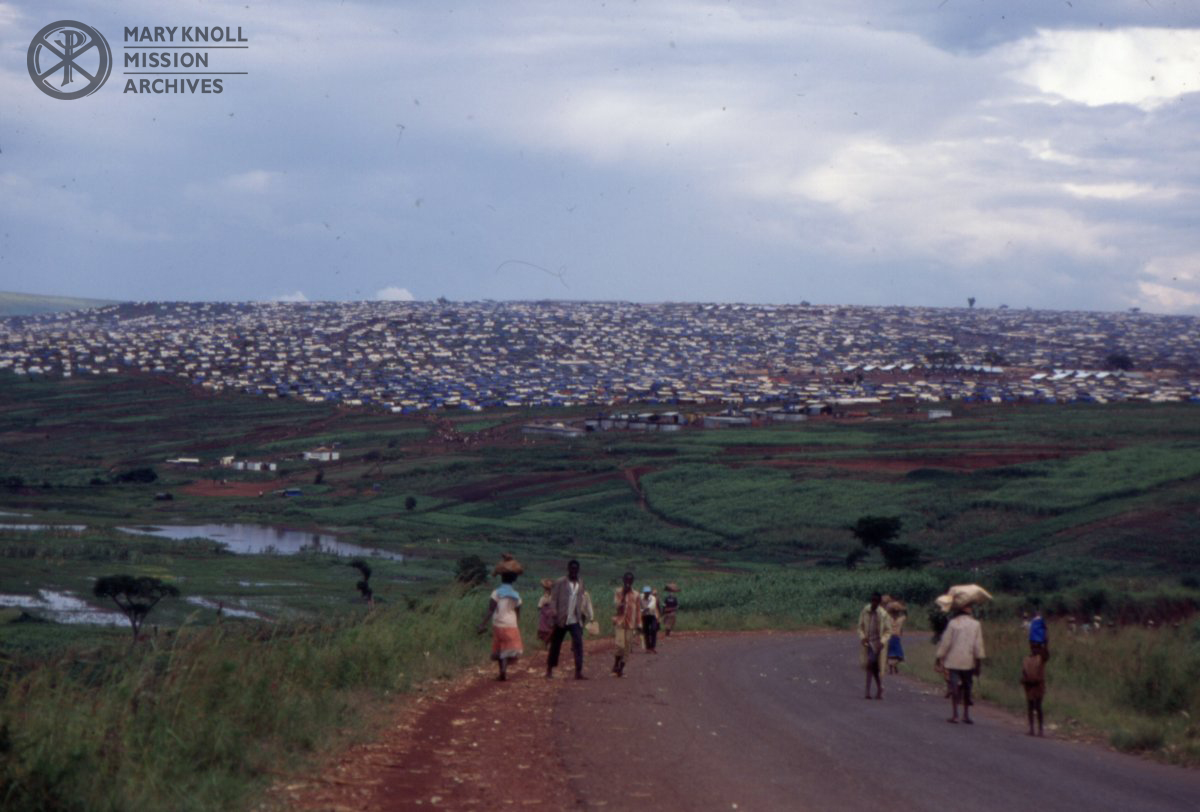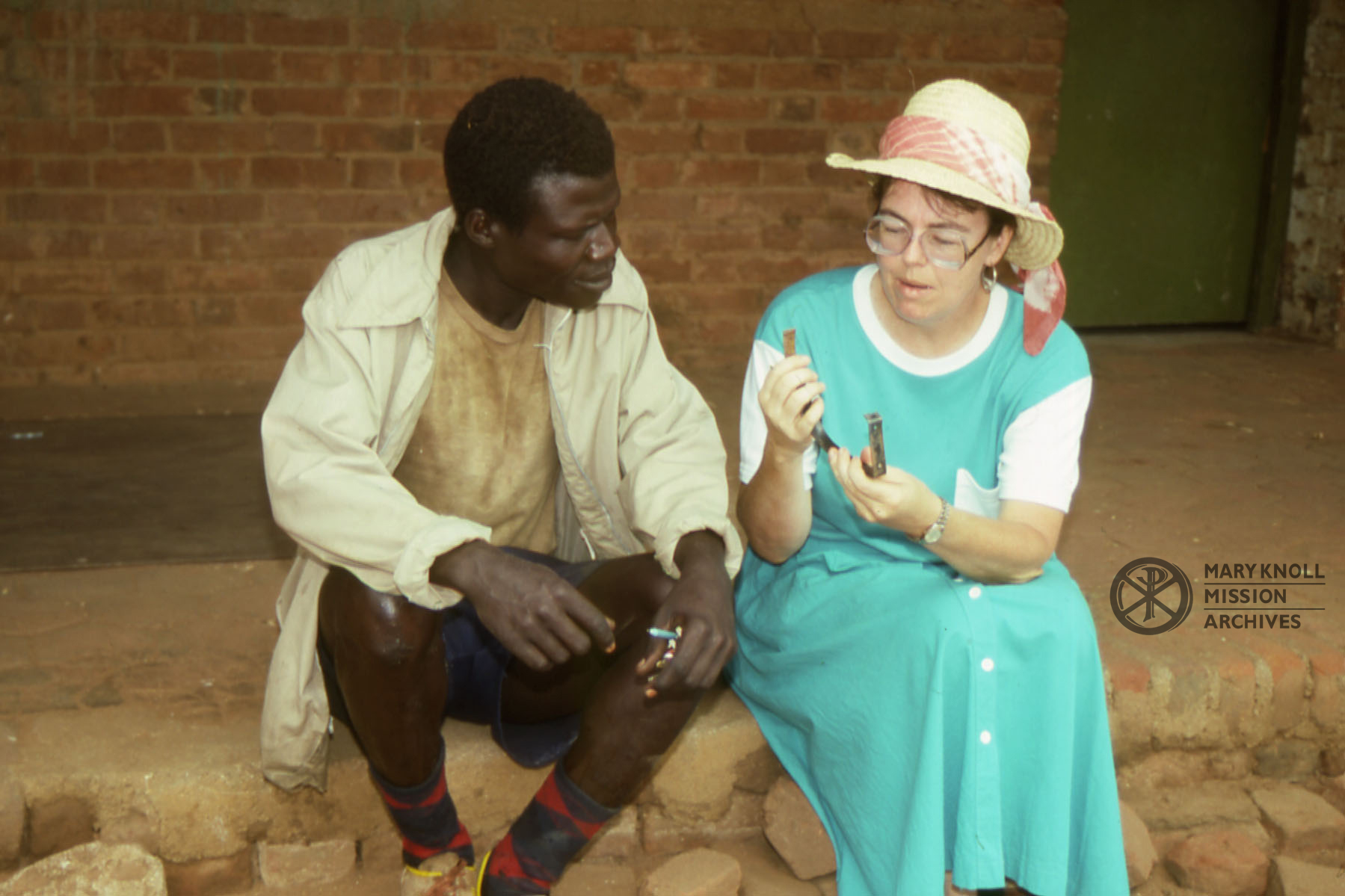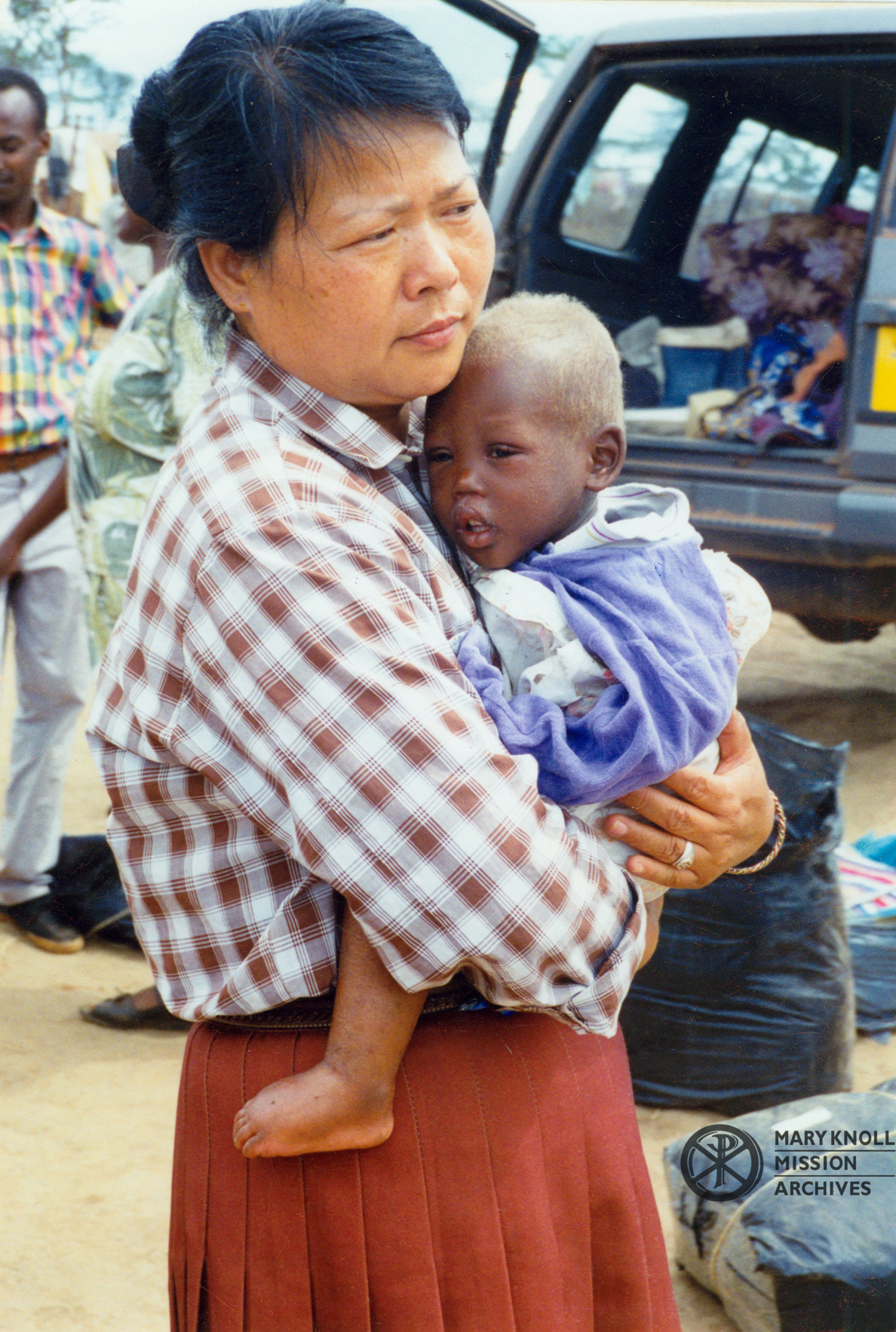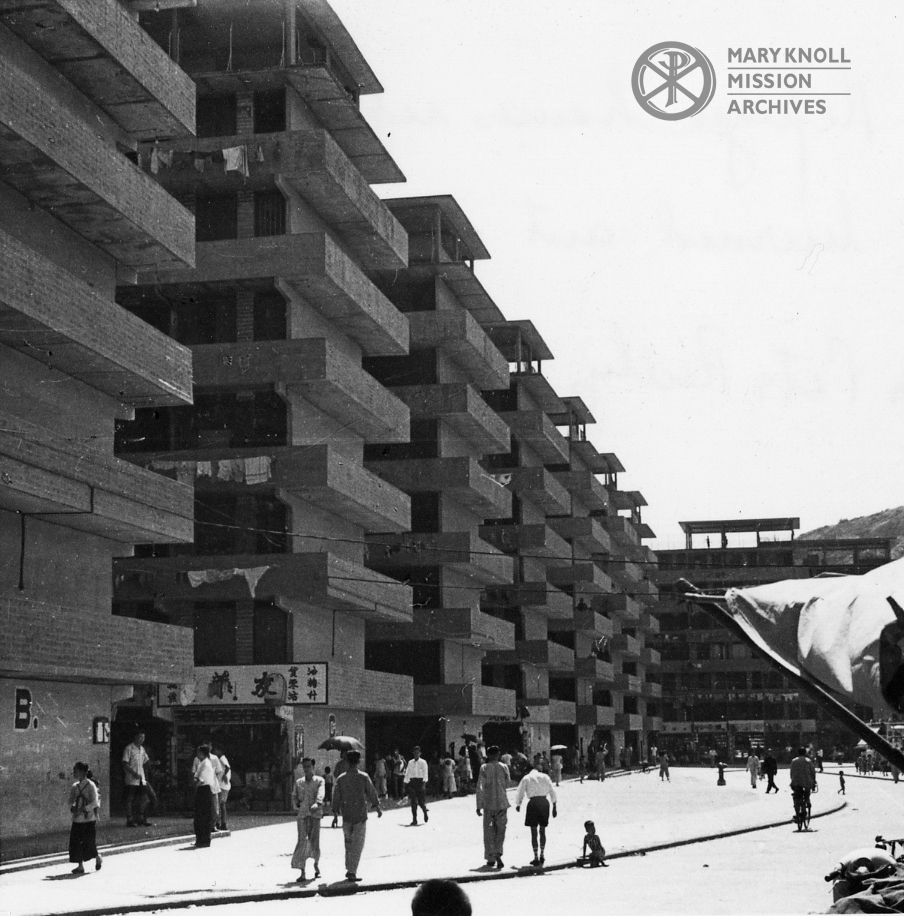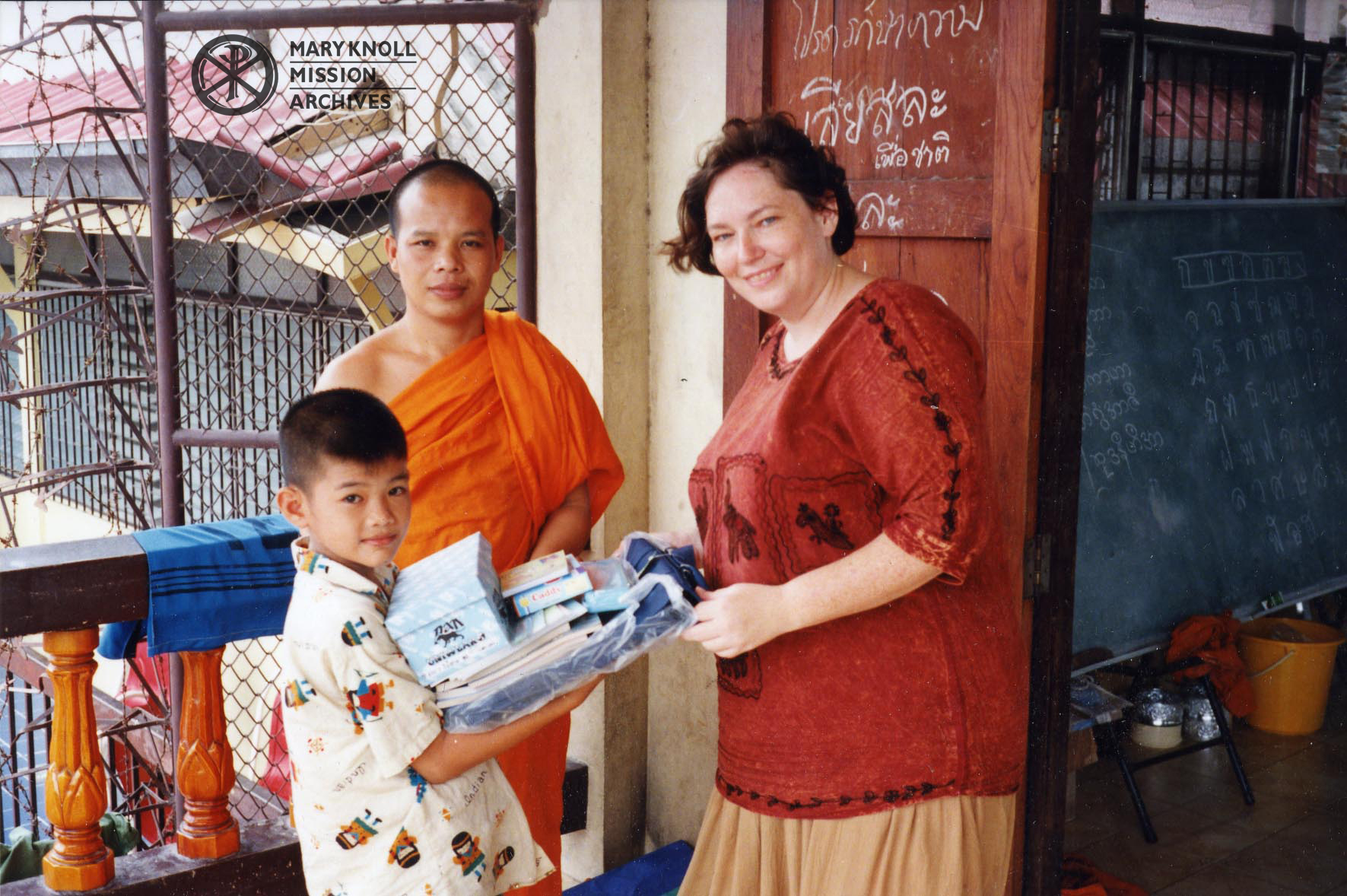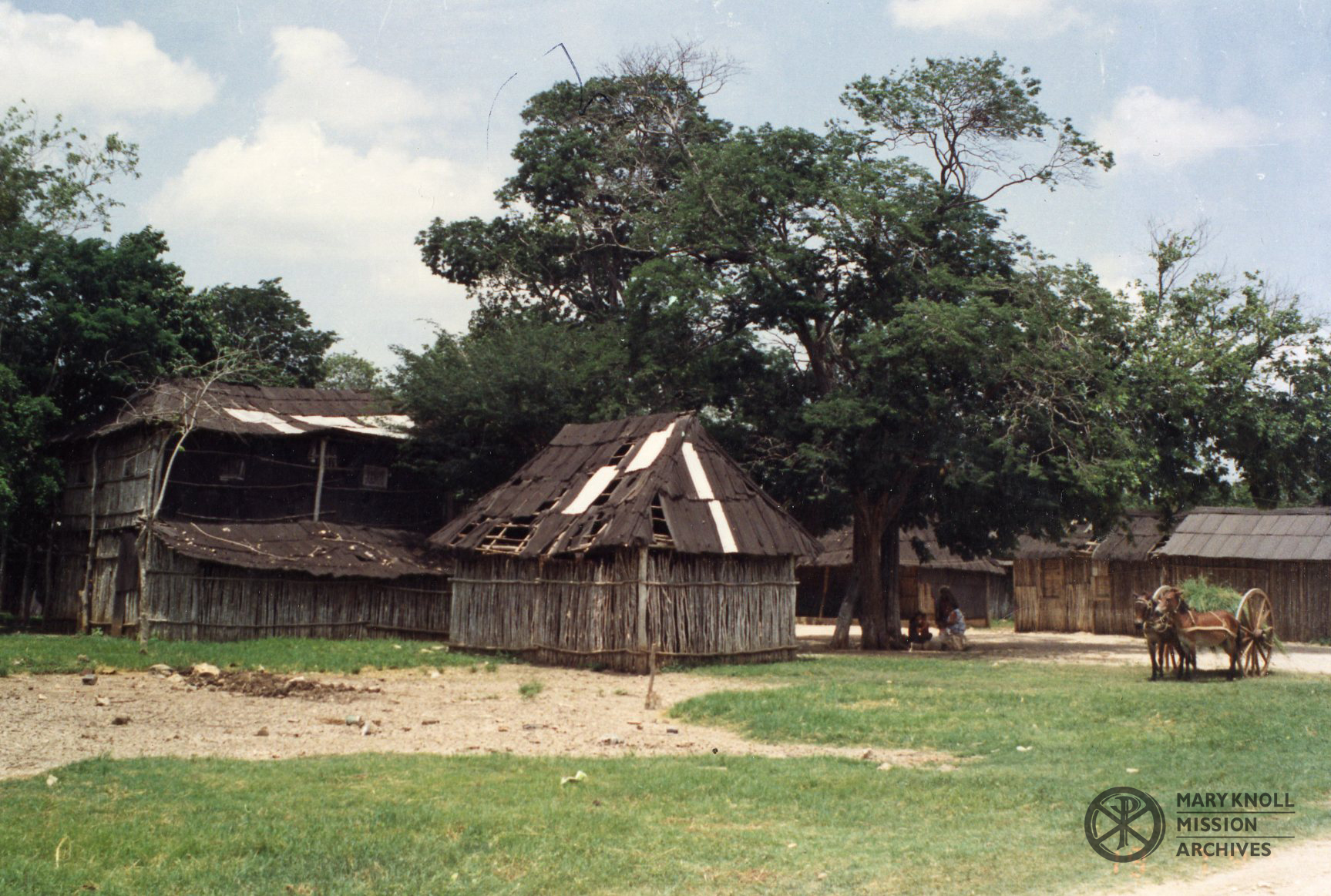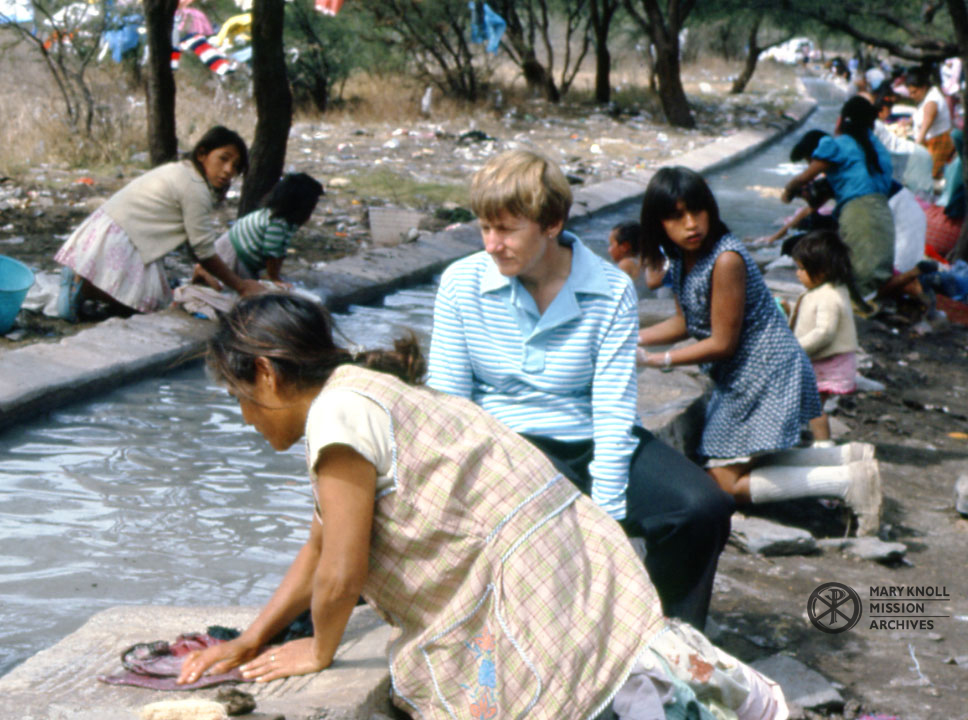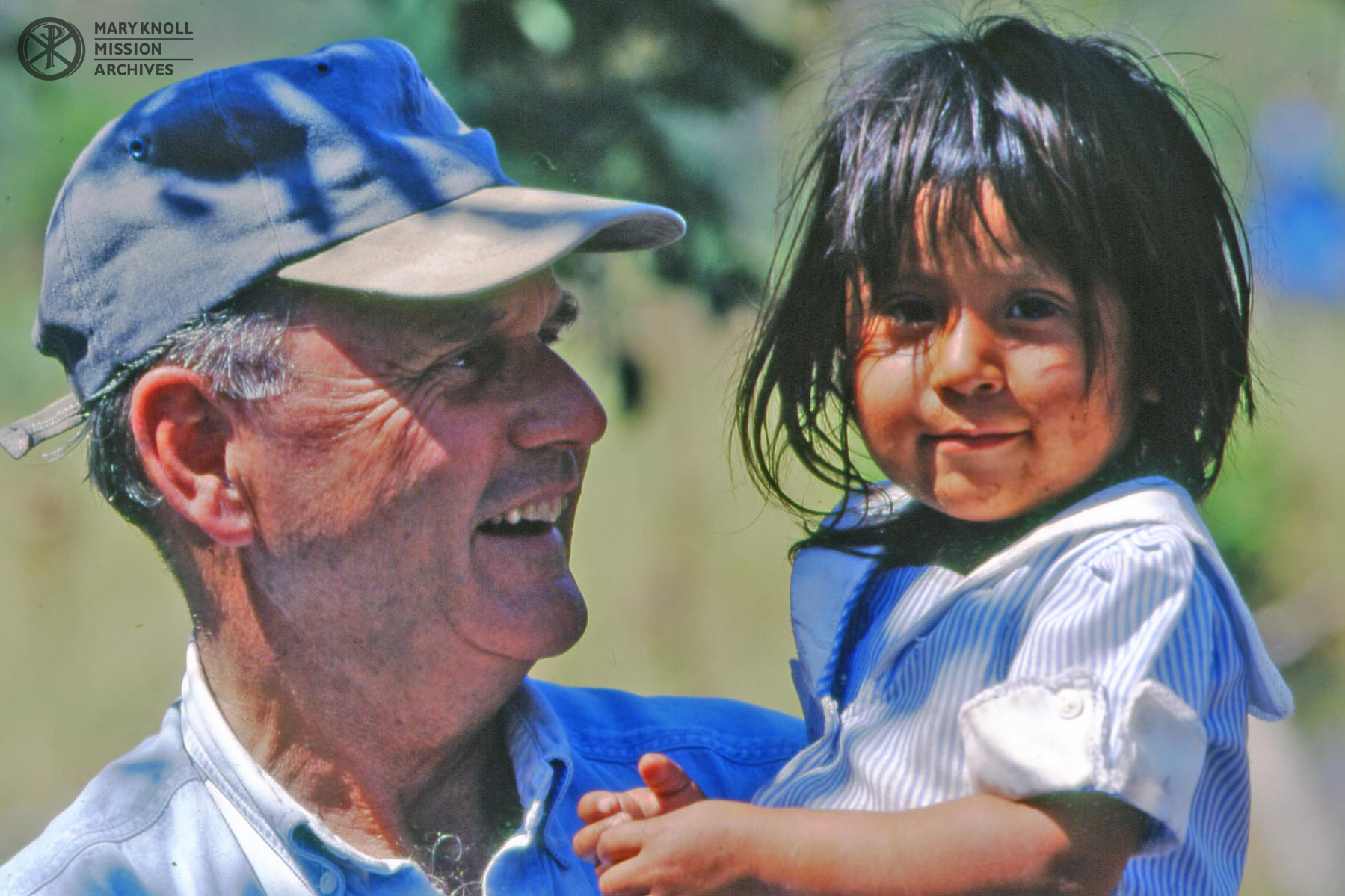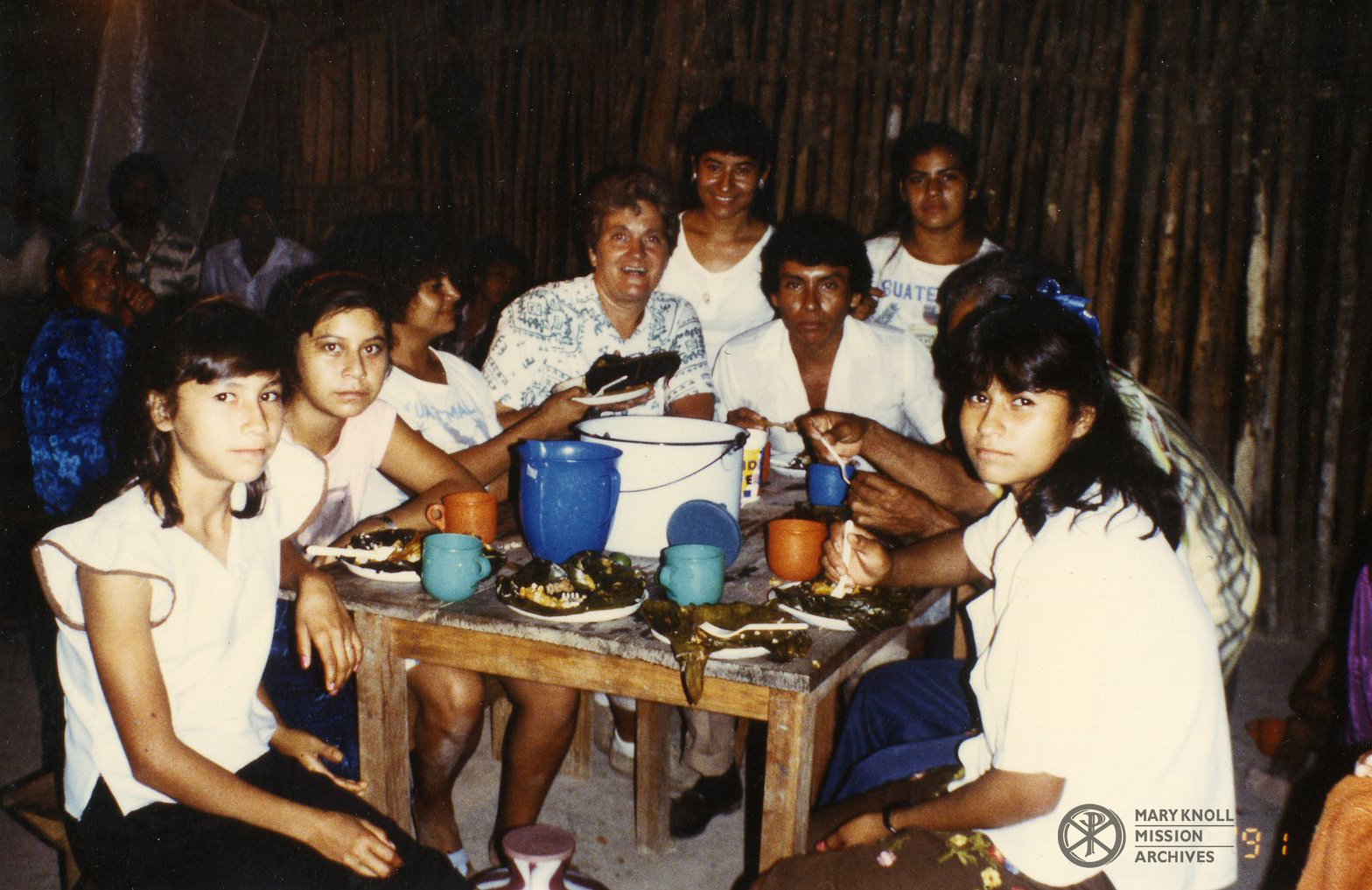June 20th is World Refugee Day, where we honor all those displaced from their home countries. Be it natural disasters, war, or political strife, refugees are uplifted and forced into unfamiliar lands seeking safety and asylum. While some settle in new countries and restart their lives, many more simply wish to return to their homes.
Over its long history, Maryknoll has assisted refugees from around the globe. From the genocides and wars of Rwanda and Ethiopia, to the political Strife of China and Southeast Asia, to the many Guatemalans escaping massacres. Maryknoll Fathers, Brothers, Sisters, and Lay Missioners have all assisted in supporting the displaced and advocating for their rights. Join me as I feature just a few of Maryknoll’s Missioners working with refugees in the areas of Africa, Asia, and Latin America.
Africa
A number of wars and conflicts occurred in West Africa during the 1980s and 1990s, displacing many peoples. Among the many missioners who went to help the refugees was Lay Missioner Liz Mach, Fr. Dan Ohmann, and Sr. Li Ching (Lekheng) Chen.
When Liz Mach saw news reports about the thousands of refugees fleeing from conflict in Ethiopia, she felt compelled to act. Armed with her medical knowledge and overseas experience, Liz traveled to the refugee camps in Sudan to lend her skills. She spent 6 months amongst the Ethiopian people, offering her medical expertise and sharing in their grief over what was lost.
In the wake of the Rwandan Genocide, survivors found their way to Burundi, and eventually to Tanzania seeking refuge. A number of Maryknoll Fathers and Sisters went to help, including Fr. Dan Ohmann and Sr. Li Ching (Lekheng) Chen. They both worked at the many Refugee Camps, attempting to form a sense of community amongst the scattered refugees.
Liz Mach in the Ethiopian Refugee Camps in Sudan
In a 1986 episode of Voices of Our World, Maryknoll Lay Missioner Liz Mach talked about her experiences as a nurse in Ethiopian Refugee Camps located in the Sudan. She talks about why she went, the expectations of refugee workers, the realities of the camp, and what it felt like to leave Sudan.
Liz Mach in the Ethiopian Refugee Camps in Sudan
Fr. Edward Hayes, Report on Fr. Dan Ohmann’s work at the Lokole Refugee Camp in Tanzania
After lunch Noel, myself [Fr. Edwards Hayes], and another Loretto Sister set off for Lokole Camp where [Fr.] Dan Ohmann is stationed. It is about a half hour’s drive from Ngara. When we arrived we found Dan’s mud house all locked up. Outside there is a small tent from which emerged a young hutu man… the Watchman. He informed us that Dan had gone to Rolenge and would not be returning until the next day. Noel did not have her ‘walkie-talkie’ with her so we drove into the camp where she borrowed a radio from a UN vehicle and called in to JRS that we were going on to Rolenge. That was an hour’s drive and there we found Dan at the Diocesan Hostel. Noel left me there and returned to Ngara. It was certainly very kind of her to take me on to Rolenge.
It was good to see Dan. He looks fine and is very involved in his work of forming ‘small Christian communities’ in Lokole Camp…
I discovered that the Hutu in Lokole Camp are from Burundi not from Rwanda. These are the people that I heard about when I was in Rome during the African Synod… So the residents of Lokole Camp are these Hutu who fled the massacres in 1993. The Rwanda Hutu came over in 1994 after the genocide when the Tutsi army invaded from Uganda and took over power.
Sr. Li Ching (LeKheng) Chen, Poem from a Rwandan Refugee Camp
I am a youth
There are many dreams I have had
many fantasy dreams I had made.
many I had reached, many I have to wait.
A Nightmare came so sudden,
no time for me to think but run.
In a foreign land,
I sat on the top of the hill
looked at the direction from where I came.
I buried my head into my hand
cried for Rwanda my sweet mother land.
I am a refugee, I have lost my home land.
As days went by,
I realized the nightmare had broken my dreams into
thousands of pieces that made me afraid.
I am afraid to see the broken dreams,
I am afraid to dream again.
I do not know how to put the broken dreams together,
I do not know how to dream again.
I am a Refugee, but I am youth.
Isn’t it the nature to have dreams for our lives?
how can a life go on without a dream?
I am a refugee, but I am a youth.
affirmation to my identity is what I need.
I am a refugee, but I am a youth.
I want to set my spirit on fire
let it burst into flame,
to continue my dreams,
to keep my hopes alive.
I painfully wait,
struggling for transformation.
Oh Friend, open your arm give me your hand,
with a heart of compassion
we can start to understand.
Support my dreams
strengthen my struggles
reach out your hand across the land.
“Urakoze” is the word of thanks I saw,
“Amahoro” is God’s peace for you I pray.
Asia
The Asia region is where some of Maryknoll’s oldest refugee work took place. Their work started with supporting those displaced from China following the Chinese Communist Revolution. Over the years, Maryknoll also worked with those fleeing the various conflicts in Southeast Asia. Just a few of the missioners supporting refugees in Asia are Suzy Comerford, Vicki Armour-Hileman, and Sr. Ann Reusch.
Suzy Comerford was hired by the Maryknoll Society to act as the Refugee Response Coordinator in Asia. While she was not an official Lay Missioner, Suzy worked diligently to aid the many refugees in Hong Kong and accross Asia. She spent about 5 years in the role, during which she brought awareness to the many needs of refugees.
For Vicki Armour-Hileman, her time spent amongst the Burmese refugees in Thailand was life changing. As she details in her book, Singing to the Dead, Vicki along with other Maryknollers worked to support the many peoples escaping persecution in Burma. From working with local Mon Buddhists to navigating bureaucratic tape, Vicki learned how tough it is to get refugees the help they need in a foreign land.
Sr. Ann Reusch spent many of her mission years working with the people located in and around Hong Kong. Her refugee work started with aiding Chinese refugees escaping Communist China, setting up schools and housing. Later in her ministry, she would eighteen months working with the Vietnamese Boat People as they flooded into Hong Kong to escape the conflict in Vietnam.
Suzy Comerford overseas Maryknoll’s response to Asia’s Refugees
As Refugee Response Coordinator for Maryknoll in Asia, Suzy Comerford has a lot of experience working with refugees. On a 1989 episode of Voices of Our World, she speaks about how refugees are often unwelcome in the countries they flee to, and how we should treat all those suffering equally.
Suzy Comerford overseas Maryknoll's response to Asia's Refugees
Vicki Armour-Hileman works with Burmese Refugees in Thailand
In 1989, Maryknoll Lay Missioner Vicki Armour-Hileman appeared on Voices of Our World to discuss her time assisting refugees in Thailand. She speaks about working with Buddhist Monks and other Maryknollers to aid Burmese refugees in finding a new home.
Vicki Armour-Hileman works with Burmese Refugees in Thailand
Sr. Anne Reusch, Research on Vietnamese Refugee Camps in Hong Kong
The Shum Shui Po transit camp is intended to accommodate 4500 people, but is overtaxed with the 2000 there already. Double decker beds are jammed one next to the other with barely enough space between for a thing person to walk. Only the blankets some have hung over the foot of the beds gives any privacy at all. Each person is given an adequate U.S. $1.75 a day for food. There is no main kitchen and kerosene burners are not allowed, but residents can get box meals from nearby restaurants, go out to eat, or cook in electric rice cookers. During the day, many adults go out to work. Officially this is illegal, but the law is not enforced as it is felt the job market can absorb them. Some women promptly have home industries set up on their beds.
Latin America
Much of Maryknoll’s Latin American refugee work focused on the conflicts in Central America. In particular, many Maryknollers flocked to the aid of Guatemalan refugees escaping to Mexico. Among these missioners were Sr. Marian Pahl, Br. Marty Shea, and Sr. Bernice Kita.
In Guatemala, the Government was in a long conflict with Guatemalan Guerilla fighters. In an effort to stop the food supply for the Guerillas, the Guatemalan Government began indiscriminately massacring local farming villages. The survivors of these massacres fled to the Mexico border searching for safety.
It is estimated that over one million Guatemalans were displaced during this time, most of them finding refugee in villages along the Mexican border. In Campeche, Mexico, over 40,000 refugees would come to call it home. This is where many of Maryknoll’s missioners went to support the refugees in what ways they could.
Sr. Marian Pahl talks about the reality for Guatemalan Refugees
Maryknoll Sister Marian Pahl appears on a 1984 episode of Voices of Our World, discussing the plight of Guatemalan refugees fleeing to Mexico. She talks about what drove the refugees from their homes and why they cannot return.
Sr. Marian Pahl talks about the reality for Guatemalan Refugees
Br. Marty Shea, Diary from Guatemalan Refugee Camp
I’m writing this by candlelight and most of the houses have grown dark and soon will grow quiet for the night. I’m tired tonight as we came from Merida with some people that went of medical attention. The sun got hot on the return trip and took the strength out of us. Things would be easy if the sun didn’t take so much out of us…
We know so many cruel facts. As a result of oppressive violence in Guatemala some 50,000 people have been killed since 1979 and continue to die every day of heartbreak and disease. It is estimated that a million Guatemalans have been displaced from their homes…
But Facts aren’t faces… Refugees are a living reality, a world tragedy from Africa to the Middle East… from Thailand to Central America. They are the unlucky to be born across a river, a street, a few miles from some dividing line marks by barbed wire.
Its night as I write and I wonder why I write at all. But write I must if in some way I can help tell their story… give a face to the statistics. Will they be heard? Will the secret and horror of Guatemala ever be known? That’s why I write on a night like tonight.
Sr. Bernice Kita, Reflections from Quetzal Edzna, Sept 26, 1989, “The Refugees”
The Refugees didn’t always look this way. Or smell this way. Or feel this way, or think this way, or live this way. There was a time – they remember it well – when they were not refugees.
The refugees have very good, very long memories. They have to. The experiences stored in their memories are too many and too important to forget…
The refugees remembers the physical sense of relief in the midst of sickness, weariness, and mourning, when they crossed the border into Mexico. Some were pursued by soldiers and barely escaped. Others had the good fortune to lose their pursuers ad crossed calmly the invisible national boundary line in the field or the jungle or the formidable rivers into Mexico. After eight years, Maria could still describe her feeling:
“When we crossed over into Mexican territory we hid in the jungle again, under the trees, hiding from the helicopters. And we prayed together, in that holy place – I call it holy because that lump that we felt in our hearts – it seems that when we got to that place, it was like taking a cool refreshing cup of spring water, and our hearts were refreshed, and each of us felt it. It was as if we had left Guatemala a year ago, and it was just that same morning. I started to pray, and I invited Rosalio and the others join me.”
Mexico was never a land they coveted. They had lived on their own “promised land” until they were driven out. But Mexico was like a second promised land, offering them shelter, safety friendship, and food. Mexico offered them refuge, and so they became Refugees.

